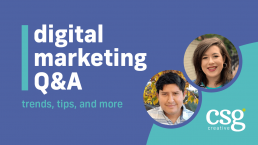For the first installment of CSG’s Digital Marketing Q&A Series, I sat down with our Digital Marketing Manager to talk a little bit about cookies, trends, and what’s next in digital advertising.
Hello, Peter! Thank you for taking time today to chat with me about some digital marketing topics. To kick things off, why don’t you introduce yourself and explain what you do at CSG Creative.
Sure! Hello, my name is Peter Cajamarca, and I am the Digital Marketing Manager at CSG Creative. A little bit about me – my background is in hospitality where I worked as a Digital Strategist. Since joining CSG, I do a lot of behind-the-scenes work for our clients and work alongside account managers to strategize and execute various digital campaigns.
Great! Thank you. On that note, let’s dive into our first question:
Q1: What’s going on with cookies and third-party data?
Well, fortunately things have been delayed, so if anyone reading this isn’t already aware, Google has postponed eliminating cookies until 2023.
Fortunately for now, but it’s looking inevitable.
True! Well, basically what people are worried about is that we won’t have the ability to build retargeting audiences from third-party cookies. These cookies have been a way to keep tabs on prospects and deliver them specific ads across websites based on their interests and behavior. It’s typically one of the highest converting, highest engaging type of campaign. So that’s why people are freaking out. But it’s not the end of the world! Google’s working on alternatives called FLoC’s which I think are going to basically become the same thing as third-party cookies.
What are FLoC’s?
Federated Learning of Cohorts. Google describes it as a “new way for businesses to reach people with relevant content and ads by clustering large groups of people with similar interests”. There’s an on-going discussion around this development, so it will be interesting to see how they’re eventually implemented.
It seems like there’s a lot coming down the pipeline, so we’ll definitely have to revisit this down the road during one of our next chats.
Q2: What are some 2021 trends that you’ve seen are worth noting?
Definitely the biggest thing has been the emergence of virtual versus hybrid versus in-person marketing campaigns. Depending on the type of event and audience, the conversion metrics vary. For example, while virtual may not be the best revenue-builder, we’re seeing it’s a lot easier to accumulate conversions on the digital side.
That makes sense since virtual experiences are easier to access, and you don’t need to do much planning ahead to attend. I imagine prospects are more incentivized to register – even up to the last minute.
Totally. Other trends that have been big for us include video advertising. We’ve been incorporating a lot of video content into our campaigns and overall, they’ve been working very well. Other digital trends that we’re going to continue seeing will include more programmatic advertising. That’s been pretty much the standard and we’re using it more and more often, now.
Any trends that you haven’t implemented, yet, but would like to?
Actually, I would really like to introduce chatbot advertising into our campaigns. So, basically, LinkedIn offers an ad that operates as a chat message. Much like those automatic “Hello, how are you?” pop-up messages you might see when you visit a company website. You can equip it with responses and information based on the types of questions the visitor feeds it.
That’s so fun!
Yeah, and other types of advertisements that have been on the rise include podcast advertising and even advertisements for your Amazon Echo or Google Home. Those might not be as effective for niche audiences, but it’s still interesting to see how those platforms are being used.
Q3: Moving on to our last question – what should businesses, industries, marketers, etc be considering for 2022?
A major trend that we’re going to be seeing more and more of regarding digital marketing is going to be “privacy”. Being transparent about advertisements and how they’re reaching certain people. Social platforms have already launched features that inform users how and why they’re seeing certain advertisements and who is creating them. Something we’ve been seeing with our campaigns is that Google is picking different accounts to “confirm identification” so now when someone receives one of these ads, they’ll be able to see who owns the ad and provide details about them. Transparency is going to become a bigger component of digital marketing tactics and I’m curious to see how that’s going to evolve over the next year or so.
In Conclusion…
Well, thank you again for joining me, today, Peter. I appreciate you taking the time to be interviewed by me for our first installment of CSG’s “Digital Marketing Q&A“. To wrap this up, can you please share a parting thought about our conversation, today? Hopes, dreams, fears?
Well, I’m feeling optimistic about everything. I know it’s been a weird year, case-in-point, I joined CSG when everyone began working remote…
That’s right!
I know, it’s been an adjustment, but we’ve been seeing a lot of good news and positive developments, so I’m looking forward to what’s coming down the pipeline for CSG and the events industry.

